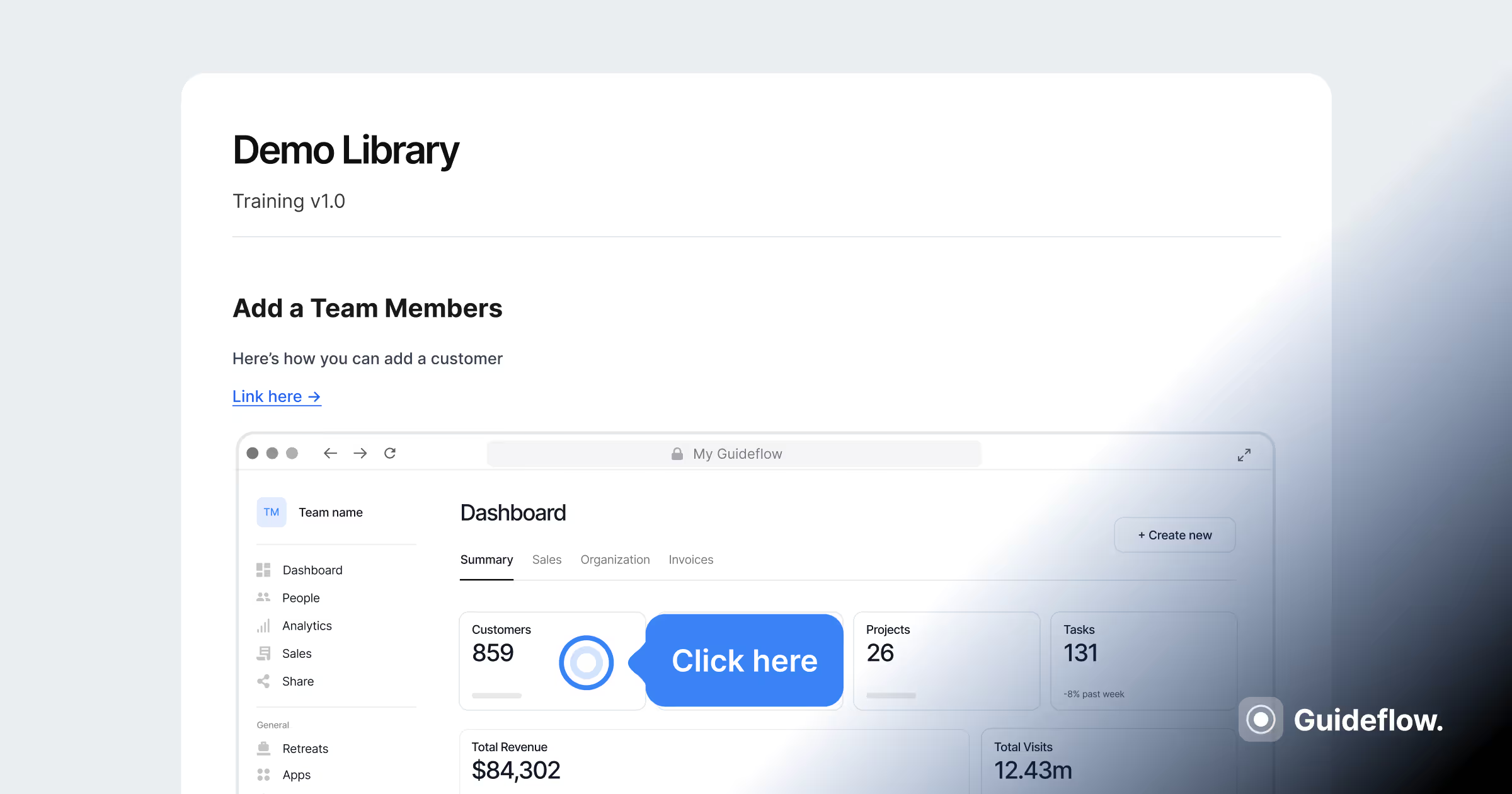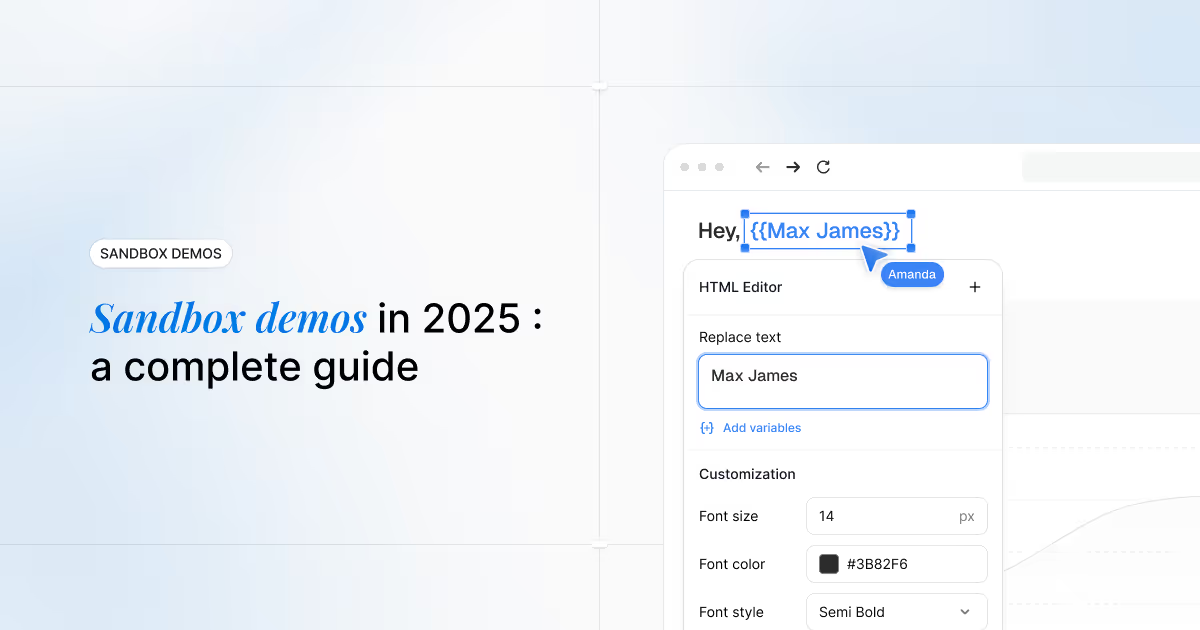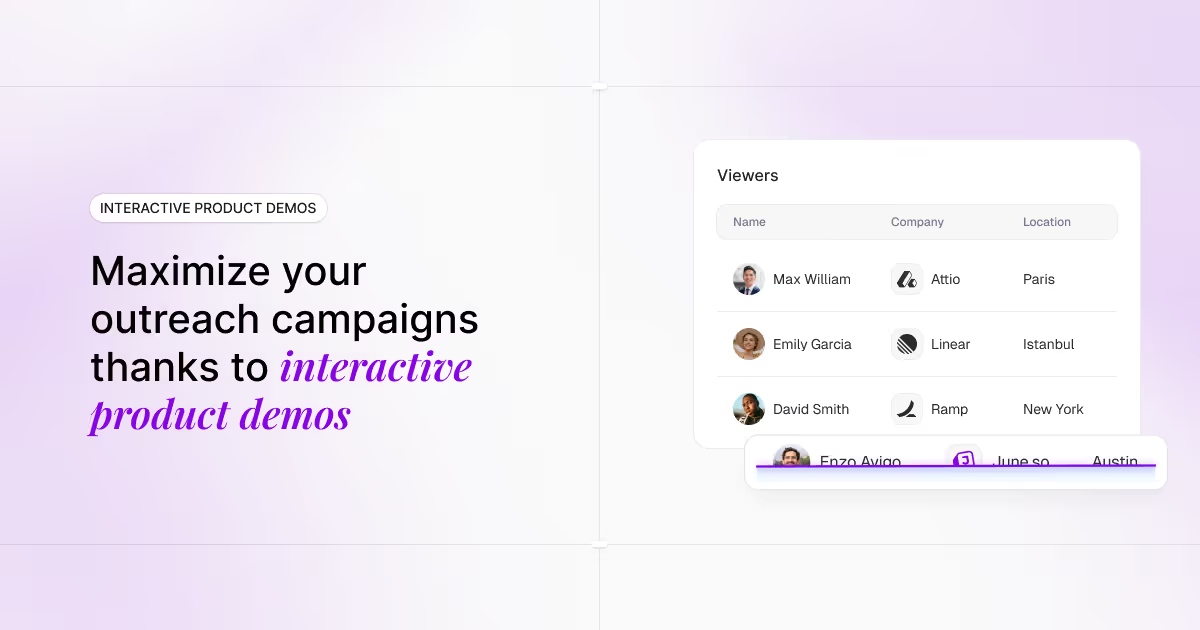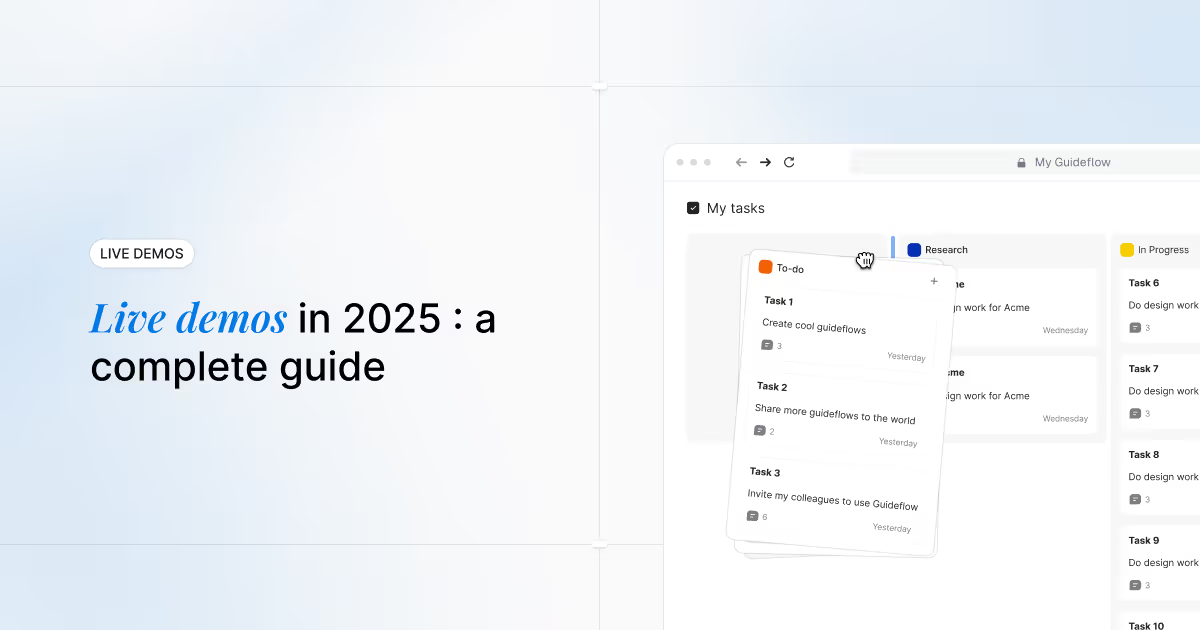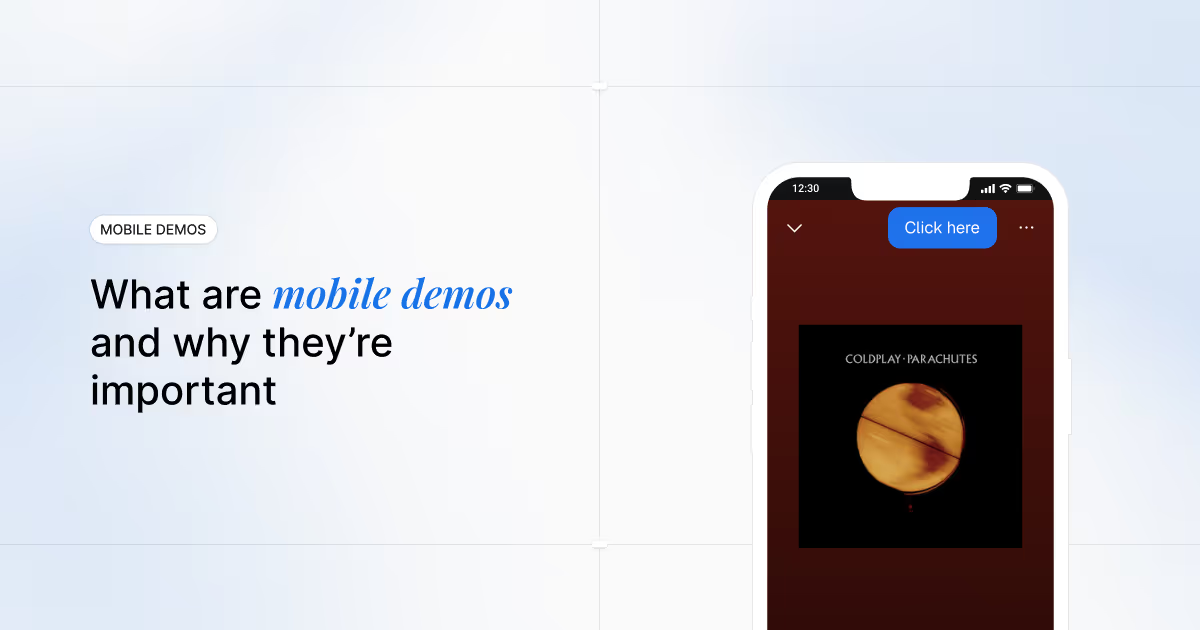What is a sandbox demo and why it's important for sales teams
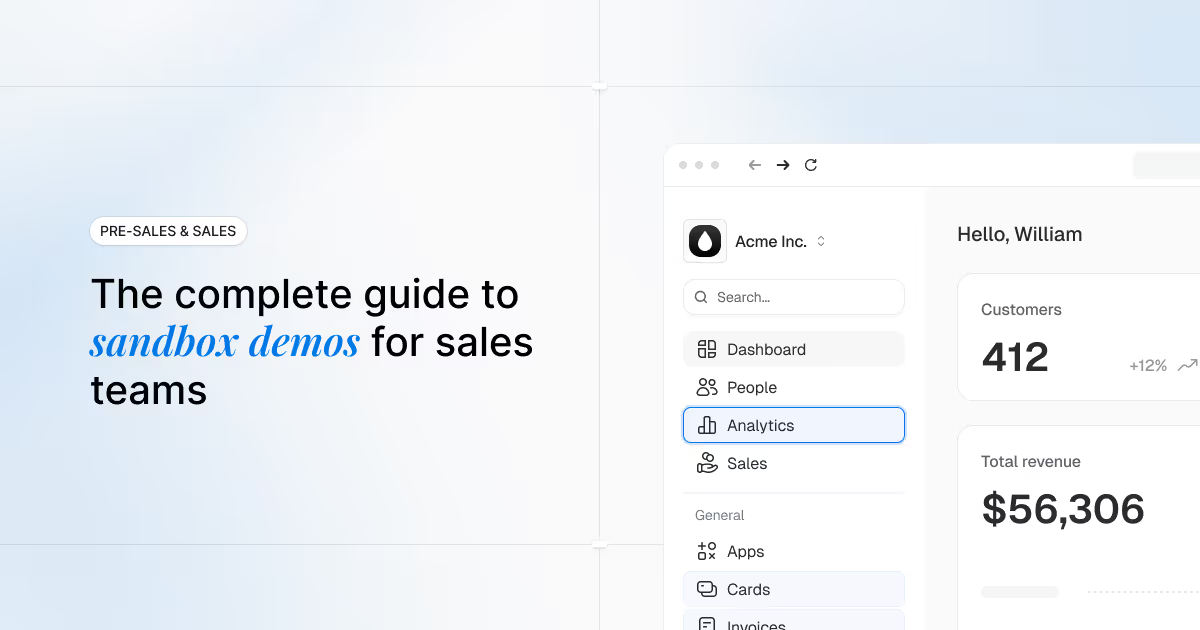


Every sales rep knows this scenario: You've got a promising lead on the call, they're asking great questions, and you're building momentum. Then you hit the demo portion and everything goes sideways.
Your staging environment crashes, the Wi-Fi stutters, or worse, the prospect glazes over watching you click through features they can't interact with themselves. You're left apologizing for technical difficulties while your carefully crafted narrative crumbles. The prospect politely says they'll "circle back internally," but you both know the moment is lost. What should have been your strongest selling point just became your biggest liability.
But here's an even more insidious problem: the deals you never get to demo at all. Your prospect is ready to see the product today, but your presales engineer is booked solid for the next two weeks. By the time you coordinate schedules, set up the environment, and finally deliver that demo, your hot lead has gone cold. They've moved on to a competitor who could show them the product immediately, or worse, the internal urgency that drove their interest has evaporated entirely.
This isn't just a scheduling problem. It's a structural inefficiency in how teams demo, with multiple failure points along the buyer journey:
Other structural problems beyond SE dependency
- AEs lack product fluency: Without hands-on demo tools, AEs often default to pitching slides instead of showing the product. This erodes credibility, creates "tell, not show" conversations, and makes buyers wait longer to see real value.
- Inconsistent demo quality: Every AE runs a demo differently, and without a controlled sandbox, the product story becomes inconsistent across the team. That means prospects hear different narratives depending on who they talk to.
- Fragile demo environments: Live demos in production or shared accounts are prone to breaking, exposing irrelevant data, or showing unfinished features. One glitch in a demo can instantly tank buyer confidence.
- Lost deal velocity: Demos become scheduling exercises ("when's presales free?"), killing momentum at the exact moment the buyer is most engaged.
- Pipeline coverage limits: Because SEs are finite, you simply cannot demo every opportunity at the speed the market demands. Many mid-sized deals never get the demo love they deserve.
- Misuse of top talent: SEs end up spending 50–70% of their time on "day one" 101 demos, instead of high-value solutioning, integrations, and late-stage validation.
TL;DR: Why this guide matters
Most SaaS organizations are unintentionally slowing their sales cycles and inflating CAC because SEs are pulled in too early for basic demos, AEs lack the tools to confidently demo on their own, and demo quality is inconsistent, fragile, and hard to scale.
The net effect? A sales motion that burns through expensive resources, stalls deals, and limits pipeline capacity.
This presales dependency doesn't just slow individual deals, it systematically destroys pipeline velocity. Every delay compounds: longer sales cycles mean higher customer acquisition costs, reduced quota attainment, and diminished ROI on your go-to-market investments. When your most expensive technical talent becomes the bottleneck for every demonstration, you're not just losing deals, you're bleeding operational efficiency. The math is brutal: organizations report that presales dependencies can extend sales cycles by 30-50% while inflating CAC through resource inefficiency and opportunity cost.
Meanwhile, your prospects are drowning in vendor demos that all look the same. Static screen shares, one-way presentations, and environments they can't touch or explore. They sit through your carefully rehearsed feature walkthrough, but they're not truly experiencing your product's value. They're just watching you use it.
The disconnect is profound: Your product solves real problems, but your demo format prevents prospects from discovering that value themselves. Traditional demos tell prospects about your solution.
What they really need is to feel the solution working for their specific challenges.
Therefore, sandbox demos have emerged as one of the most efficient tools for SaaS companies to address these structural challenges. By accelerating deals, driving sign-ups, reducing technical risks, freeing up presales resources, and enabling scalable product exploration, sandbox demos have become mission-critical assets across the go-to-market funnel.
Sandbox demos solve the resource efficiency equation while addressing each structural problem:
- Eliminate solution engineer dependency for 70-80% of demo requests (addresses talent misuse and pipeline coverage limits)
- Enable AE product fluency through hands-on demo tools (addresses credibility and "tell vs show" problems)
- Standardize demo quality across all team members (addresses inconsistent narratives and messaging)
- Remove technical fragility with risk-free environments (addresses staging failures and reliability concerns)
- Enable immediate demonstration without scheduling delays (addresses lost deal velocity)
- Scale demonstration capacity without proportional headcount increase (addresses resource constraints)
With growing pressure to achieve more with increasingly limited resources, particularly on the sales side, optimizing your approach to sandbox demos directly impacts your sales pipeline velocity, reduces costs, and improves ROI on go-to-market investments while solving the fundamental operational inefficiencies that constrain growth.
Let's dive into what makes sandbox demos powerful and how to implement them for real business impact.
What is a sandbox demo?
A sandbox demo is an interactive, clickable replica of your product that sales teams use during live calls. Unlike screen-sharing or static presentations, sandbox demos allow prospects to independently explore your actual interface elements and workflows. Prospects can click, navigate, and experience your product as if they were using the real thing.
Think of it as giving prospects the keys to test drive your software without any of the setup, security, or performance risks that usually come with live demo environments. Every button click, menu navigation, and workflow completion happens in a controlled environment that feels authentic while remaining completely secure.
How sandbox demos work
Guideflow's Chrome extension captures HTML snapshots of your product interfaces and automatically connects them into seamless, interactive experiences. When you click through workflows during capture, the system maps those interactions and creates a self-contained environment where prospects can follow the same paths or explore on their own.
The result is a demo that preserves your product's actual look, feel, and functionality while eliminating dependencies on staging servers, internet connectivity, or technical configurations. Your prospects get hands-on product experience while you maintain complete control over the demonstration flow.
Sandbox vs. interactive demos: understanding the key differences
While both sandbox demos and interactive demos create engaging product experiences, they serve different purposes and offer distinct user experiences:
Sandbox demos are best when you want prospects to experience your product as if they were actual users, clicking freely, exploring different sections, and discovering capabilities on their own. They excel for:
- Proof of concept scenarios where prospects need to validate specific functionality
- Sales presentations where you want prospects to feel ownership through hands-on interaction
- Saving hours for presales teams by eliminating the need to create demo environments
- Competitive evaluations where free exploration reveals workflow advantages
- Training environments where learners need realistic practice
Interactive demos work better when you have a specific story to tell or workflow to demonstrate in a controlled sequence. They're ideal for:
- Onboarding new users through essential features step-by-step
- Marketing campaigns that need to communicate specific value propositions
- Feature announcements that require guided explanation
- Sales presentations with time constraints that need focused messaging
The choice between sandbox and interactive demos depends on your objectives: use sandbox demos when exploration and discovery matter most, and interactive demos when guided education and controlled messaging are priorities.
Why sandbox demos are game-changers for sales teams
Sales teams face structural challenges that other demo approaches can't solve: technical reliability issues that undermine credibility, AE product fluency gaps that force dependence on slides, and resource constraints that limit pipeline coverage. Sandbox demos directly address each of these systemic problems while generating behavioral intelligence that improves every subsequent sales interaction.
Solving the AE product fluency crisis
Without hands-on demo tools, AEs default to slide presentations that create "tell, not show" conversations. This credibility gap becomes more pronounced when prospects ask detailed product questions or request specific workflow demonstrations that slides simply cannot address effectively.
Sandbox demos transform AEs into confident product demonstrators. By practicing in realistic environments and delivering hands-on experiences, AEs develop genuine product fluency that translates into credible prospect conversations. When AEs can navigate product workflows confidently and answer questions through live demonstration rather than theoretical explanations, they establish technical credibility that drives purchase decisions.
Standardizing demo quality across teams
Every AE currently runs demos differently, creating inconsistent product narratives across the team. Prospects hear different value propositions, feature explanations, and competitive positioning depending on which team member they encounter. This inconsistency undermines brand messaging and creates confusion during complex enterprise sales cycles involving multiple stakeholders.
Sandbox environments enable consistent demonstration quality while maintaining personalization flexibility. Sales teams can standardize core messaging, workflow demonstrations, and competitive positioning through shared sandbox templates while allowing individual AEs to customize data, scenarios, and industry-specific examples. This approach ensures prospects receive consistent product narratives regardless of which team member leads the demonstration.
Eliminating technical fragility that destroys credibility
Live product demonstrations introduce risk into your most important sales conversations. Staging environments crash, integrations fail, and network issues derail carefully planned presentations. These technical failures don't just interrupt your demo presentation, they actively undermine confidence in your product's reliability and professional competence.
Sandbox demos eliminate technical variables entirely. Your sandbox environment loads instantly, performs consistently, and never depends on servers, databases, or network connections. When prospects experience smooth, reliable product interaction, they associate that reliability with your actual solution while you maintain credibility throughout the sales process.
Restoring deal velocity through immediate demonstration
The current model where "demos become scheduling exercises" kills momentum precisely when buyers are most engaged. Qualified prospects expressing strong interest must wait days or weeks for presales availability, allowing competitors to capture attention or internal priorities to shift away from your solution.
Sandbox demos enable immediate product demonstration when interest peaks. AEs can respond to prospect questions with hands-on exploration instead of scheduling follow-up calls. This responsiveness maintains engagement momentum while demonstrating your organization's efficiency and customer focus - competitive advantages that influence final vendor selection.
Solving pipeline coverage limitations
Because SEs are finite resources, organizations cannot demo every opportunity at market speed. Mid-sized deals receive inadequate demonstration attention while high-value prospects consume disproportionate technical resources. This resource allocation problem limits overall pipeline conversion and prevents teams from pursuing every qualified opportunity effectively.
Sandbox demos scale demonstration capacity without proportional headcount increases. Every AE becomes capable of delivering effective product demonstrations, enabling teams to pursue all qualified opportunities regardless of presales availability. This expanded capacity improves overall pipeline conversion while allowing SEs to focus on high-value technical validation activities.
Advanced behavioral analytics reveal buying intent
Every interaction within a sandbox demo provides granular insight into prospect interest and engagement depth. You can see which features capture attention, what workflows they complete, where they spend time, and which capabilities they ignore. This behavioral data reveals genuine product interest versus polite meeting participation - crucial intelligence for complex enterprise sales cycles.
Unlike traditional demos that provide only qualitative feedback, sandbox environments generate quantitative engagement metrics that enable sophisticated lead scoring and follow-up personalization. When prospects spend significant time exploring advanced features, you have concrete evidence of expansion opportunity backed by demonstrated interest.
Passive viewing limits real understanding
Traditional screen-sharing demos create one-way experiences where prospects watch you navigate your product but never interact with it themselves. They see features but don't experience workflows firsthand. This passive consumption fails to create the visceral understanding that drives purchase decisions.
Interactive sandbox environments transform prospects from passive observers into active users. When they click through workflows, complete tasks, and explore features independently, they develop a genuine, intuitive understanding of your product that presentations simply cannot achieve. This hands-on engagement creates an emotional bond with your product.
Advanced behavioral analytics reveal buying intent
Every interaction within a sandbox demo provides granular insight into prospect interest and engagement depth. You can see which features capture attention, what workflows they complete, where they spend time, and which capabilities they ignore. This behavioral data reveals genuine product interest versus polite meeting participation.
Unlike traditional demos that provide only qualitative feedback, sandbox environments generate quantitative engagement metrics that enable sophisticated lead scoring and follow-up personalization. When prospects spend significant time exploring advanced features, you have concrete evidence of expansion opportunity backed by demonstrated interest.
Key features that make sandbox demos powerful
Modern sandbox demo platforms, such as Guideflow, offer capabilities designed specifically to solve the structural problems that constrain sales team effectiveness. Here are the essential features that address AE product fluency gaps, demo consistency issues, and resource optimization challenges:
Clickable product environments that build AE confidence

Sandbox demos preserve your product's actual interface elements with full interactivity intact, enabling AEs to practice realistic customer scenarios and build genuine product expertise. Prospects can navigate menus, complete forms, trigger workflows, and experience realistic user scenarios while AEs demonstrate mastery through hands-on guidance rather than theoretical presentations.
This authentic interaction solves the credibility problem that emerges when AEs default to slide presentations. When prospects see AEs navigating product workflows confidently and answering questions through live demonstration, they perceive technical competence that influences purchase decisions.
Presenter notes for consistent messaging
While prospects explore your sandbox demo independently, presenter notes give AEs complete control over messaging consistency without restricting interactive exploration. Private talking points, hidden navigation cues, and presentation controls ensure uniform value proposition delivery while maintaining the hands-on experience prospects value.
This feature directly addresses the inconsistent demo quality problem by providing AEs with standardized messaging frameworks while preserving demonstration flexibility and personalization opportunities.
Real-time customization capabilities that eliminate delays
Modify demo content, data sets, and scenarios instantly during sales conversations without scheduling follow-up calls or requesting presales support. When prospects mention specific use cases or industry challenges, AEs can adapt the sandbox environment immediately rather than experiencing the "lost deal velocity" problem that kills momentum.
This capability restores AE autonomy by eliminating dependence on technical resources for basic demonstration customization while maintaining the personalization that complex prospects require.
Comprehensive engagement analytics for pipeline optimization
Track prospect behavior at granular detail: time spent in each section, features explored, workflows completed, and interaction patterns. This data enables precise follow-up conversations and provides concrete evidence for internal prospect scoring and prioritization, intelligence that improves resource allocation across the entire pipeline.
These insights help sales teams identify which opportunities deserve presales investment versus those that can be advanced through AE-led demonstration, optimizing the talent allocation problem that currently misuses expensive technical resources.
Multi-device responsiveness for continued engagement
Sandbox demos function seamlessly across desktop, tablet, and mobile devices without additional configuration. Prospects can continue exploring your product after sales calls, share demonstrations with colleagues, and access content from any device, that extends engagement beyond scheduled meeting times.
This accessibility addresses the pipeline coverage limitation by enabling prospect self-service exploration that supplements live demonstration time without consuming additional sales or technical resources.
Integration with sales tools for workflow optimization
Modern sandbox demo platforms integrate with CRM systems, sales engagement platforms, and marketing automation tools. These integrations automatically update lead scores, trigger follow-up sequences, and deliver behavioral insights to sales teams within their existing workflows, streamlining the administrative overhead that reduces AE selling time.
Where and when to use sandbox demos in the sales cycle
Sandbox demos excel in specific sales scenarios where the structural problems of AE product fluency, demo consistency, technical fragility, lost velocity, pipeline coverage limits, and talent misuse create the most friction.
Discovery call preparation that builds AE confidence
Send prospects sandbox demos before scheduled discovery calls so they arrive with basic product familiarity while AEs review engagement analytics to understand prospect interests. This preparation enables deeper strategic conversations focused on business outcomes rather than basic feature education, while building AE confidence through advanced knowledge of prospect priorities.
Prospects who explore your product beforehand ask better questions and engage more meaningfully during live discussions, while AEs demonstrate expertise by addressing specific workflows prospects explored independently.
Live sales presentations that eliminate technical risk
Replace screen-sharing with interactive sandbox environments where prospects can navigate while you guide the conversation. This approach maintains presentation structure while giving prospects hands-on experience that passive viewing cannot provide. Technical reliability ensures smooth demonstrations regardless of connectivity or staging environment status—eliminating the credibility damage from technical failures.
AEs can focus on consultative selling rather than technical troubleshooting, while prospects experience product reliability that builds confidence in your solution's operational stability.
Competitive differentiation moments that leverage hands-on exploration
When prospects mention competitor evaluations, immediately demonstrate your product's unique approaches to shared challenges through interactive sandbox exploration. Unlike theoretical feature comparisons, hands-on workflow differences help prospects understand integration advantages and user experience improvements that static presentations cannot convey effectively.
This approach transforms competitive conversations from claims-based discussions into evidence-based demonstrations that prospects can verify through direct experience.
Multi-stakeholder demonstrations that scale efficiently
Enterprise sales often requires demonstrations for technical evaluators, business stakeholders, and executive decision makers simultaneously. Sandbox demos enable each audience to explore relevant workflows independently while you address questions and facilitate group discussions without managing multiple screen-sharing sessions or coordinating separate presales resources.
This efficiency addresses the pipeline coverage problem by enabling comprehensive stakeholder engagement without multiplying technical resource requirements.
Post-call follow-up that maintains momentum
Share customized sandbox environments after successful sales conversations to reinforce key demonstration points and enable internal prospect advocacy. Champions can walk colleagues through the same workflows you demonstrated, maintaining demonstration quality and messaging consistency without requiring additional sales engineering resources.
This self-service capability extends your demonstration reach while preserving the consistent product narrative that influences group purchase decisions.
Partner and channel enablement that scales without overhead
Equip partner sales teams with sandbox demos they can deliver independently without requiring your technical resources or deep product expertise. Partners can demonstrate your product's value proposition effectively while you maintain control over messaging and user experience quality, solving the resource constraint problem across channel networks.
Practical sales use cases and measurable impact
Leading sales teams deploy sandbox demos in specific scenarios where the structural problems of traditional demonstration approaches create bottlenecks, inconsistency, or resource misallocation.
Use case 1: Interactive sandbox demonstrations with personalized scenarios
Challenge
Traditional product demonstrations often rely on generic workflows that fail to resonate with specific prospect environments, while AEs struggle to demonstrate how their product addresses unique business challenges without defaulting to slide presentations. Additionally, the heavy involvement of presales teams creates bottlenecks in demo environment creation, exemplifying the talent misuse problem where SEs spend time on basic demonstrations instead of high-value solutioning.
Solution
Sandbox demo environments simulate the prospect's specific use case, industry data, and business scenarios while enabling AEs to navigate confidently through realistic product workflows. Prospects can explore product functionality hands-on while experiencing workflows personalized to their exact requirements, building AE credibility through demonstrated product expertise.
Benefits
- Solves AE product fluency gaps: Interactive environments build genuine product expertise through hands-on practice
- Addresses demo consistency issues: Standardized sandbox templates ensure uniform messaging while enabling personalization
- Eliminates technical fragility: Risk-free environments prevent staging failures that undermine credibility
- Restores deal velocity: Immediate customization capabilities eliminate scheduling delays for basic demonstration needs
- Optimizes talent allocation: SEs focus on complex technical validation while AEs handle product exploration independently
When to use
- During formal sales demonstrations with qualified prospects requiring industry-specific scenarios
- For complex products where AE product fluency directly impacts credibility and conversion
- With prospects who prefer self-guided exploration over passive presentation formats
- When presales resources are constrained and basic product demonstrations create bottlenecks
Pro tip: Use pre-configured sandbox setups for common industries or use cases to reduce prep time while maintaining customization for high-value prospects.
Use case 2: Proof of concept and safe trial environments
Challenge
Traditional trials require extensive technical setup, expose production systems to risk, and often fail because prospects can't configure realistic scenarios. Long setup cycles overwhelm presales teams with basic configuration requests while qualified prospects lose momentum waiting for technical validation—exemplifying both the talent misuse and lost deal velocity problems.
Solution
Deploy sandbox environments as safe trial spaces where prospects can experience realistic product functionality without setup friction. Quick spin-up capabilities enable immediate evaluation with custom configurations that replicate their data and integrations, while preserving presales resources for complex technical validation.
Benefits
- Eliminates velocity-killing delays: Instant trial access removes setup barriers that cause prospects to lose interest
- Addresses pipeline coverage limits: Self-service evaluation enables broader prospect engagement without technical resource multiplication
- Solves talent misuse: SEs focus on complex integration validation rather than basic product configuration
- Maintains demo consistency: Standardized trial environments ensure uniform product experience across all prospects
- Removes technical fragility: Zero risk to production systems while providing realistic product capability demonstrations
When to use
- For short-term proof of concept requirements where setup delays typically kill momentum
- When prospects need technical validation before purchase decisions but presales resources are constrained
- With enterprise prospects requiring extensive evaluation periods without corresponding technical support availability
- For products where traditional trials create security concerns or setup complexity that overwhelms prospects
Pro tip: Create template sandbox environments for common integration scenarios to accelerate PoC delivery while maintaining customization flexibility.
Use case 3: Sales engineering and rapid solution prototyping
Challenge
Presales engineers spend excessive time building custom environments for each prospect while facing pressure to validate complex integrations quickly. This exemplifies the talent misuse problem where expensive technical resources focus on basic demonstration setup rather than high-value solutioning activities that truly require specialized expertise.
Solution
Enable sales engineers to rapidly prototype solutions and validate integrations within sandbox demos, focusing their expertise on complex technical challenges while AEs handle basic product demonstration through standardized environments. Test configurations, demonstrate connectivity to prospect tech stacks, and experiment with complex workflows without production system risks.
Benefits
- Optimizes talent allocation: SEs focus on integration validation and complex solutioning rather than basic demo setup
- Accelerates technical validation: Rapid prototyping reduces presales engineering cycle time for qualified opportunities
- Scales technical expertise: Reusable configurations improve team efficiency across similar prospect requirements
- Eliminates technical fragility: Risk-free experimentation enables comprehensive solution validation without production impact
- Improves pipeline coverage: SEs can support more qualified opportunities when basic demonstrations are AE-independent
When to use
- During technical evaluation phases with engineering stakeholders requiring complex integration validation
- When prospects require technical proof before purchase but basic product demonstration creates presales bottlenecks
- For complex technical sales requiring custom configuration proof without extensive resource allocation
- With prospects evaluating multiple technical scenarios where rapid iteration improves competitive positioning
Pro tip: Build a library of common integration patterns and technical configurations that sales engineers can quickly adapt for prospect-specific requirements.
Use case 4: Internal sales training and rep onboarding
Challenge
New sales representatives struggle to learn complex products through static materials and presentations, creating the AE product fluency problem that forces dependence on slide presentations. Inconsistent training across teams and geographies leads to varied demonstration quality and messaging—the demo consistency problem that confuses prospects and undermines brand positioning.
Solution
Deploy interactive sandbox demos for scenario-based training where new hires can practice real customer challenges and solutions. Standardized learning environments ensure consistent product knowledge across all team members regardless of location while building genuine hands-on expertise that translates into credible prospect demonstrations.
Benefits
- Builds genuine AE product fluency: Interactive learning creates hands-on expertise that eliminates dependence on slide presentations
- Standardizes demo quality: Consistent training environments ensure uniform messaging and demonstration approaches
- Accelerates rep productivity: Scenario-based practice builds confidence for live prospect interactions faster than theoretical training
- Scales training efficiency: Self-paced exploration accommodates different learning styles without multiplying trainer resources
- Improves competitive positioning: Confident AEs who demonstrate product expertise influence prospect purchase decisions more effectively
When to use
- During new sales representative onboarding programs where product fluency directly impacts quota attainment
- For ongoing team training on new features or capabilities that require hands-on understanding
- When standardizing demonstration approaches across global teams to ensure consistent prospect experiences
- For complex products requiring extensive hands-on learning that static materials cannot provide
Pro tip: Create progressive training scenarios that build complexity over time, starting with basic workflows and advancing to enterprise-level demonstrations and objection handling.
Use case 5: Channel partner enablement and self-serve training
Challenge
Channel partners lack deep product expertise and ongoing technical support for effective demonstrations, creating the pipeline coverage problem where qualified opportunities receive inadequate demonstration attention. Traditional partner training requires significant resource investment while maintaining inconsistent quality across partner organizations - extending the talent misuse problem across channel networks.
Solution
Provide partners with self-serve sandbox demos where they can learn and demonstrate the product safely. Enable resellers and partners to explore at their own pace while maintaining consistent messaging and user experience quality, solving both the demo consistency and pipeline coverage challenges simultaneously.
Benefits
- Solves pipeline coverage limitations: Partners can demonstrate effectively without extensive technical training or ongoing support
- Addresses demo consistency: Standardized environments ensure uniform product narrative regardless of partner expertise
- Optimizes resource allocation: Self-serve environments scale enablement across large partner networks without proportional support investment
- Eliminates technical dependencies: Partners deliver demonstrations without requiring internal technical resource coordination
- Maintains competitive positioning: Consistent demonstration quality preserves brand messaging and competitive differentiation across channels
When to use
- When scaling through channel partner programs where direct sales presence requires supplementation
- For partners with limited technical resources who need immediate demonstration capabilities
- In markets where competitive advantage depends on immediate product demonstration availability
- When partner technical expertise varies significantly but demonstration quality consistency is critical
Pro tip: Create partner-specific sandbox libraries organized by market segment or customer type, enabling partners to quickly find relevant demonstration scenarios.
Use case 6: Competitive selling with side-by-side comparisons
Challenge
Prospects evaluating multiple vendors struggle to understand meaningful differences between similar solutions, while sales reps often resort to feature comparisons that fail to demonstrate experiential advantages. This creates the AE product fluency challenge where theoretical discussions cannot effectively communicate workflow superiority and user experience advantages.
Solution
Use controlled sandbox environments to showcase features and workflows in direct contrast with competitive approaches. Enable prospects to experience your unique methodology, integration capabilities, and user experience advantages through hands-on exploration rather than theoretical explanations, building AE credibility through evidence-based demonstrations.
Benefits
- Transforms competitive positioning: Side-by-side workflow comparisons reveal meaningful differences that feature lists cannot communicate
- Builds AE credibility: Evidence-based demonstrations replace claims-based competitive discussions
- Eliminates technical risks: Reliable sandbox environments prevent demonstration failures during critical competitive moments
- Enables immediate differentiation: Real-time customization addresses competitive objections through hands-on proof rather than scheduled follow-up
- Improves win rates: Prospects experience differentiation rather than just hearing theoretical explanations
When to use
- During competitive displacement opportunities where workflow advantages drive purchase decisions
- When prospects explicitly compare multiple vendor solutions in formal evaluation processes
- In final vendor evaluations where experiential differentiation influences selection outcomes
- For prospects influenced by competitor marketing where hands-on experience counters competitive claims
Pro tip: Develop sandbox scenarios that highlight your unique workflow advantages in areas where competitors typically struggle or require workarounds.
Use case 7: Customer education and strategic upselling
Challenge
Existing customers under-utilize advanced features and premium capabilities, limiting expansion revenue opportunities while customer success teams struggle with traditional upselling approaches that rely on theoretical value propositions rather than demonstrated capability and business impact.
Solution
Let existing customers explore new features, premium tiers, and advanced functionality through dedicated sandbox environments. Enable customers to test unused capabilities and experience upgrade value before committing to higher-tier investments, while customer success teams demonstrate expansion value through hands-on exploration.
Benefits
- Drives feature adoption: Hands-on exploration builds confidence in unused capabilities that theoretical training cannot achieve
- Improves expansion revenue: Customers experience upgrade value before purchase decisions, reducing expansion sales cycle length
- Reduces implementation concerns: Hands-on testing eliminates upgrade hesitation and implementation objections through direct experience
- Enables consultative upselling: Customer success teams focus on business outcomes rather than feature explanations
- Provides expansion intelligence: Engagement analytics identify expansion opportunities and optimal timing for upselling conversations
When to use
- During renewal conversations with identified expansion opportunities where hands-on validation improves close rates
- When introducing new features or product capabilities that require customer confidence building
- For customers showing interest in advanced functionality who need validation before tier upgrades
- With strategic accounts requiring justification for additional investments where ROI demonstration is critical
Pro tip: Track customer exploration patterns in sandbox environments to identify expansion opportunities and time upselling conversations based on demonstrated interest and engagement depth.
How to create a sandbox demo in 5 steps
Creating a powerful sandbox demo requires strategic thinking focused on solving the structural problems that constrain sales team effectiveness: AE product fluency gaps, demo consistency issues, technical fragility, lost deal velocity, pipeline coverage limits, and talent misuse.
Step 1: Define your structural problem focus
Start with clear identification of which structural challenges your sandbox demo will address:
- AE product fluency: Are you building environments that help AEs practice and demonstrate expertise confidently?
- Demo consistency: Do you need standardized messaging frameworks while maintaining personalization flexibility?
- Technical reliability: Are you eliminating staging environment dependencies that create demonstration failures?
- Deal velocity: Will your sandbox enable immediate demonstration without scheduling delays?
- Pipeline coverage: Can your approach scale demonstration capacity without proportional resource increases?
- Talent optimization: Does your design preserve presales resources for high-value technical validation?
Clear structural problem identification determines your sandbox's scope, complexity, and measurement criteria for operational impact.
Step 2: Map realistic scenarios that build AE confidence
Identify authentic workflows that solve the product fluency challenge while delivering genuine prospect value:
- Choose scenarios that demonstrate clear business problem resolution through hands-on interaction
- Focus on workflows that build AE expertise through repeated practice and demonstration
- Ensure scenarios reflect realistic data and configurations that prospects can relate to their environments
- Prioritize outcomes and results that prospects can achieve independently through exploration
- Design experiences that enable AEs to guide confidently without technical support
Keep scenarios focused and purposeful. One compelling user journey that builds AE expertise beats comprehensive feature coverage that overwhelms learning.
Step 3: Design for consistency and flexibility
Plan the balance between standardized messaging and prospect personalization to solve the demo consistency problem:
- Entry points: How prospects enter and begin exploration while AEs maintain control over narrative flow
- Core workflows: Key pathways that demonstrate primary value propositions consistently across all team members
- Discovery moments: Opportunities for prospects to uncover additional capabilities while AEs provide expert guidance
- Customization points: Where AEs can adapt scenarios immediately without technical support or scheduling delays
- Exit actions: Clear next steps and conversion opportunities that maintain demonstration momentum
Enable free navigation while providing AEs with messaging frameworks that ensure consistent value proposition delivery across all prospect interactions.
Step 4: Build and configure for operational efficiency
Using Guideflow's sandbox capabilities to address structural challenges:
- Capture product interfaces that enable AE practice and expertise development through realistic interaction
- Connect workflow elements automatically to create seamless exploration paths that build AE confidence through repetition
- Configure customization capabilities that eliminate presales dependencies for basic scenario adaptation
- Set up analytics tracking to monitor prospect engagement and identify high-value opportunities for resource allocation
- Create standardized templates organized by industry, use case, or competitive scenario for consistent team deployment
- Establish presenter controls that enable AE messaging consistency while maintaining interactive prospect experience
Step 5: Deploy and optimize for structural impact
Use comprehensive analytics to measure resolution of the six structural problems:
- AE confidence metrics: Are team members demonstrating independently and handling product questions effectively?
- Demo consistency measurement: Do prospects receive uniform messaging and value proposition delivery across team members?
- Technical reliability tracking: Have demonstration failures and staging environment dependencies been eliminated?
- Velocity improvement analysis: Are deals progressing faster through demonstration phases without scheduling delays?
- Pipeline coverage expansion: Can teams pursue more qualified opportunities without proportional resource increases?
- Talent allocation optimization: Are SEs focusing on high-value technical validation rather than basic demonstration setup?
Leverage engagement analytics, conversion improvements, and operational efficiency gains to continuously refine your sandbox environments for maximum structural impact on sales team effectiveness.
Conclusion
Sandbox demos transform how your sales team operates by eliminating the structural inefficiencies that currently constrain performance: AE product fluency gaps, demo consistency problems, technical fragility, lost deal velocity, pipeline coverage limits, and talent misuse. Instead of defaulting to slide presentations or waiting weeks for presales coordination, your team gains the autonomy and expertise to demonstrate effectively when prospect interest peaks.
AEs develop genuine product fluency through hands-on sandbox practice, building the credibility that converts skeptical prospects into engaged buyers. Demo consistency improves as standardized environments ensure uniform messaging while preserving personalization flexibility. Technical reliability eliminates the staging failures that undermine buyer confidence at critical moments.
Most importantly, sandbox demos restore operational efficiency across your entire go-to-market motion. Deal velocity accelerates because demonstrations happen immediately rather than after scheduling coordination. Pipeline coverage expands as every AE becomes capable of effective product demonstration. Talent allocation optimizes as SEs focus on complex technical validation instead of basic demonstration setup.
Your prospects increasingly expect immediate product access and self-service evaluation capabilities. Organizations that provide these experiences first gain sustainable competitive advantages over teams still operating with traditional demonstration dependencies. The question is whether your team will lead with autonomous demonstration capabilities or continue losing deals to competitors who can show their product immediately when interest peaks.
The structural problems constraining your sales team compound daily: longer cycles, higher CAC, reduced pipeline capacity, and talent misallocation. Sandbox demos provide the systematic solution that transforms these operational inefficiencies into competitive advantages through AE autonomy, demonstration consistency, technical reliability, and optimized resource allocation.
Start by identifying which structural challenge creates the biggest constraint for your team - whether that's AE product fluency, demo consistency, technical fragility, or resource allocation - and build sandbox capabilities that eliminate those specific bottlenecks. Your quota depends on converting interest into demonstrations efficiently; sandbox demos ensure you never lose another deal to operational inefficiencies.
FAQs
How do sandbox demos differ from free trials or product tours?
Sandbox demos provide controlled, curated experiences optimized for sales conversations rather than open-ended product exploration. Unlike free trials that require account setup and onboarding, sandbox environments offer immediate access to relevant workflows. Unlike product tours that follow predetermined paths, sandboxes enable free exploration while maintaining sales team visibility and control.
What's the typical setup time for creating effective sandbox demonstrations?
Initial sandbox creation takes 10-15 minutes per workflow using modern capture technology. The Chrome extension captures HTML snapshots automatically as you navigate your product, requiring no technical configuration or environment preparation. Most sales teams deploy their first sandbox demos within days of platform access.
Can prospects break or damage sandbox demonstration environments?
Sandbox demos are completely isolated from production systems and reset automatically after each session. Prospects cannot access sensitive data, modify configurations, or impact other users' experiences. Each demonstration session operates in a secure, self-contained environment designed specifically for safe prospect interaction.
How do I measure ROI from sandbox demo investments?
Track leading indicators like engagement depth, session duration, and workflow completion rates alongside lagging metrics such as sales cycle velocity, win rates, and deal sizes. Most teams observe 30-40% improvements in sales progression speed and significant reductions in technical demo failures within 90 days of implementation.
What level of product customization is possible during live sales calls?
Modern platforms enable real-time content modification including data sets, user interface elements, and workflow scenarios. Sales reps can adapt demonstrations immediately when prospects mention specific use cases or industry requirements without scheduling follow-up calls or requesting technical support.
Should sales development and account executives use different sandbox approaches?
Yes. SDRs typically use broader demonstration environments focused on value proposition and initial interest generation, while AEs deploy more detailed, customized sandboxes that address specific business challenges and competitive differentiation. Both roles benefit from behavioral analytics that inform handoff conversations and lead prioritization.
How do sandbox demos solve the AE product fluency problem that forces dependence on slide presentations?
Sandbox demos provide hands-on practice environments where AEs develop genuine product expertise through realistic interaction. Instead of memorizing feature lists or relying on slides, AEs practice navigating actual workflows, handling product questions, and demonstrating capabilities confidently. This hands-on expertise translates into credible prospect demonstrations that build trust and influence purchase decisions.
What's the impact on demo consistency when every AE currently runs demonstrations differently?
Sandbox environments enable standardized messaging frameworks while preserving personalization flexibility. Sales teams create consistent value proposition delivery, competitive positioning, and workflow demonstrations through shared sandbox templates, while individual AEs customize data, scenarios, and industry examples. This approach ensures prospects receive uniform product narratives regardless of which team member leads the demonstration.
How do sandbox demos eliminate the technical fragility that destroys buyer confidence during critical sales moments?
Sandbox demos operate in completely isolated environments that never depend on staging servers, database connections, or network reliability. Each demonstration loads instantly and performs consistently, eliminating the technical failures that undermine credibility. When prospects experience smooth, reliable product interaction, they associate that stability with your actual solution while you maintain professional competence throughout the sales process.
Can sandbox demos really solve the "lost deal velocity" problem where demos become scheduling exercises?
Yes, by enabling immediate product demonstration when prospect interest peaks. AEs can respond to prospect questions with hands-on exploration instantly rather than scheduling follow-up calls with presales resources. Real-time customization capabilities allow immediate scenario adaptation during sales conversations, maintaining engagement momentum while demonstrating organizational responsiveness that influences vendor selection decisions.
How do sandbox demos address the pipeline coverage limitations created by finite presales resources?
Sandbox demos scale demonstration capacity by transforming every AE into an effective product demonstrator. Teams can pursue all qualified opportunities regardless of presales availability, while SEs focus on complex technical validation for high-value prospects. This expanded capacity improves overall pipeline conversion while optimizing talent allocation across the entire sales organization.
What's the measurable impact on the talent misuse problem where SEs spend 50-70% of time on basic demonstrations?
Organizations typically observe 70-80% reduction in SE involvement for basic demonstrations within 90 days of sandbox deployment. SEs redirect time toward high-value activities like complex integration validation, technical solutioning, and late-stage deal support, while AEs handle product exploration and initial evaluation independently. This optimization improves both SE utilization and overall sales team effectiveness.
Related posts
Learn more about Guideflow, our approach to authentication, and company news.




